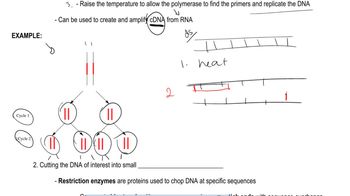Discuss the similarities and differences between forward and reverse genetic approaches, and when you would choose to utilize each of the approaches.
Table of contents
- 1. Introduction to Genetics51m
- 2. Mendel's Laws of Inheritance3h 37m
- 3. Extensions to Mendelian Inheritance2h 41m
- 4. Genetic Mapping and Linkage2h 28m
- 5. Genetics of Bacteria and Viruses1h 21m
- 6. Chromosomal Variation1h 48m
- 7. DNA and Chromosome Structure56m
- 8. DNA Replication1h 10m
- 9. Mitosis and Meiosis1h 34m
- 10. Transcription1h 0m
- 11. Translation58m
- 12. Gene Regulation in Prokaryotes1h 19m
- 13. Gene Regulation in Eukaryotes44m
- 14. Genetic Control of Development44m
- 15. Genomes and Genomics1h 50m
- 16. Transposable Elements47m
- 17. Mutation, Repair, and Recombination1h 6m
- 18. Molecular Genetic Tools19m
- 19. Cancer Genetics29m
- 20. Quantitative Genetics1h 26m
- 21. Population Genetics50m
- 22. Evolutionary Genetics29m
15. Genomes and Genomics
Functional Genomics
Problem 9
Textbook Question
Discuss the advantages (and possible disadvantages) of the different approaches to reverse genetics.
 Verified step by step guidance
Verified step by step guidance1
Reverse genetics involves studying gene function by starting with a known gene and observing the effects of its alteration or disruption. Begin by understanding the three main approaches to reverse genetics: gene knockout, gene knockdown, and gene editing.
Step 1: Gene knockout involves completely removing or disrupting a gene to study its function. Discuss its advantages, such as providing clear insights into the gene's role, and disadvantages, such as potential lethality of the knockout, which can prevent further study.
Step 2: Gene knockdown uses techniques like RNA interference (RNAi) to reduce the expression of a gene. Highlight its advantages, such as being less invasive and reversible, and disadvantages, such as incomplete suppression of the gene, which may lead to ambiguous results.
Step 3: Gene editing, often using CRISPR-Cas9, allows precise modifications to the gene sequence. Explain its advantages, such as high specificity and versatility, and disadvantages, such as potential off-target effects and ethical concerns.
Step 4: Compare these approaches in terms of their applications, such as studying essential genes, creating disease models, or developing therapies, and discuss how the choice of method depends on the research question and organism being studied.
 Verified video answer for a similar problem:
Verified video answer for a similar problem:This video solution was recommended by our tutors as helpful for the problem above
Video duration:
2mPlay a video:
Was this helpful?
Key Concepts
Here are the essential concepts you must grasp in order to answer the question correctly.
Reverse Genetics
Reverse genetics is a method used to understand the function of a gene by analyzing the phenotypic effects of specific gene sequences. This approach typically involves creating mutations in a gene of interest and observing the resulting changes in phenotype, allowing researchers to infer the gene's role in biological processes.
Recommended video:
Guided course

Genetic Cloning
Gene Targeting Techniques
Gene targeting techniques, such as CRISPR-Cas9 and homologous recombination, are essential tools in reverse genetics. These methods enable precise modifications to the genome, allowing scientists to knock out or modify specific genes. Each technique has its advantages, such as efficiency and specificity, as well as potential disadvantages, including off-target effects and ethical concerns.
Recommended video:
Guided course

Mapping Genes
Phenotypic Analysis
Phenotypic analysis involves studying the observable traits or characteristics of an organism resulting from genetic modifications. This analysis is crucial in reverse genetics, as it helps researchers determine the functional consequences of gene alterations. Understanding the advantages and disadvantages of different phenotypic assessment methods is vital for accurately interpreting the results of reverse genetics experiments.
Recommended video:
Guided course

Chi Square Analysis
Related Videos
Related Practice
Textbook Question
585
views


